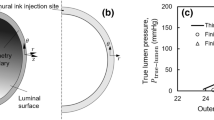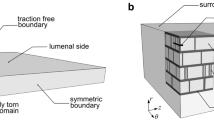Abstract
Acute aortic dissection and associated aortic catastrophes are among the most devastating forms of cardiovascular disease, with a remarkably high morbidity and mortality despite current medical and surgical treatment. The mechanics underlying aortic dissection are incompletely understood, and a further understanding of the relevant fluid and solid mechanics may yield not only a better appreciation of its pathogenesis, but also the development of improved diagnostic and therapeutic strategies. After illustrating some of the inadequacies with respect to the extant work on the mechanics of aortic dissection, we alternatively postulate that the clinical hemodynamic disturbances that render the aorta susceptible to the initiation of dissection are principally elevated maximum systolic and mean aortic blood pressure, whereas the hemodynamic disturbances that facilitate propagation of dissection are principally elevated pulse pressure and heart rate. Furthermore, abnormal aortic mechanical properties and/or geometry are requisite for dissection to occur. Specifically, we propose that the degree of anisotropy will directly influence the probability of future aortic dissection. Imaging of the aorta may provide information regarding aortic anisotropy and geometry, and in combination with a hemodynamic risk assessment, has the potential to be able to prospectively identify patients at high risk for future aortic dissection thereby facilitating prophylactic intervention. The aim of the paper is to identify the main mechanical issues that have a bearing on aortic dissection, and to suggest an appropriate mathematical model for describing the problem.
Similar content being viewed by others
References
Akosah K, Denlinger B, Mohanty P (1999) Safety profile and hemodynamic responses to beta-adrenergic stimulation by dobutamine in heart transplant patients. Chest 116:1587–1592
Alyono D, Ring W, Anderson M, Anderson R (1984) Left ventricular adaptation to volume overload from large aortocaval fistula. Surgery 96:360–367
Anagnostopoulos C, Prabhakar M, Kittle C (1972) Aortic dissections and dissecting aneurysms. Am J Cardiol 30:263–273
Atkin R, Craine R (1976) Continuum theories of mixtures: basic theory and historical development. Q J Mech Appl Math 29:209–244
Bowen R (1976) Theory of mixtures. In: Eringen A (ed) Continuum physics, vol 3. Academic Press, New York
Brookes C, White P, Staples M, Oldershaw P, Redington A, Collins P, Noble M (1998) Myocardial contractility is not constant during spontaneous atrial fibrillation in patients. Circulation 98:1762–1768
Carney W Jr, Rheinlander H, Cleveland R (1975) Control of acute aortic dissection. Surgery 78:114–120
Chand S, Rajagopal KR (2006) On the diffusion of fluids through solids undergoing large deformations. Math Mech Solids 11:291–305
Dake M, Kato N, Mitchell R, Semba C, Razavi M, Shimono T, Hirano T, Takeda K, Yada I, Miller D (1999) Endovascular stent-graft placement for the treatment of acute aortic dissection. N Engl J Med 340:1546–1552
D’Andrea A, Duceschi V, Caso P, Galderisi M, Mercurio B, Liccardo B, Sarubbi B, Scherillo M, Cotrufo M, Calabro R (2001) Usefulness of Doppler tissue imaging for the assessment of right and left ventricular myocardial function in patients with dual-chamber pacing. Int J Cardiol 81:75–83
DeBakey M, Henly W, Cooley D, Morris G Jr, Crawford E, Beall A Jr (1964) Surgical management of dissecting aneurysm involving the ascending aorta. Cardiovasc Surg (Torino) 58:200–211
Edmunds R, Greenspan K, Fisch C (1970) The role of inotropic variation in ventricular function during atrial fibrillation. J Clin Invest 49:738–746
Fowkes F, Macintyre C, Ruckley C (1989) Increasing incidence of aortic aneurysms in England and Wales. BMJ 298:33–35
Glower D, Fann J, Speier R, Morrison L, White W, Smith L, Rankin J, Miller D, Wolfe W (1990) Comparison of medical and surgical therapy for uncomplicated descending aortic dissection. Circulation 89:IV39–IV46
Gott V, Greene P, Alejo D, Cameron D, Naftel D, Miller D, Gillinov A, Laschinger J, Pyeritz R (1999) Replacement of the aortic root in patients with Marfan’s syndrome. N Engl J Med 340:1307–1313
Green A, Adkins J (1960) Large elastic deformations and nonlinear continuum mechanics. Clarendon Press, Oxford
Hagan P, Nienaber C, Isselbacher E, Bruckman D, Karavite D, Russman P, Evangelista A, Fattori R, Suzuki T, Oh J, et al (2000) The International Registry of Acute Aortic Dissection (IRAD) new insights into an old disease. JAMA 283:897–903
Halpern B, Char F, Murdoch J, Horton W, McKusick V (1971) A prospectus on the prevention of aortic rupture in the Marfan syndrome with data on survivorship without treatment. Johns Hopkins Med J 129:123–129
Kadowitz P, Nandiwada P, Gruetter C, Ignarro L, Hyman A (1981) Pulmonary vasodilator responses to nitroprusside and nitroglycerin in the dog. J Clin Invest 67:893–902
Kass D, Chen C, Curry C, Talbot M, Berger R, Fetics B, Nevo E (1999) Improved left ventricular mechanics from acute VDD pacing in patients with dilated cardiomyopathy and ventricular conduction delay. Circulation 99:1567–1573
Kouchoukos N, Dougenis D (1997) Surgery of the thoracic aorta. N Engl J Med 336:1876–1889
Kouchoukos N, Karp R, Blackstone E, Doty D, Hanley F (2003) Acute aortic dissection. Barratt-Boyes Cardiac Surgery. Churchill Livingstone, London
Maher K, Pizarro C, Gidding S, Januszewska K, Malec E, Norwood WJ, Murphy J (2003) Hemodynamic profile after the Norwood procedure with right ventricle to pulmonary artery conduit. Circulation 108:782–784
Mason D (1978) Afterload reduction and cardiac performance: physiologic basis of systemic vasodilators as a new approach in treatment of congestive heart failure. Am J Med 65:106–125
Mehta R, Suzuki T, Hagan P, Bossone E, Gilon D, Llovet A, Maroto L, Cooper J, Smith D, Armstrong W, et al (2002) Predicting death in patients with acute type a aortic dissection. Circulation 105:200–206
Mikich B (2003) Dissection of the aorta: a new approach. Heart 89:6–8
Morris G Jr, Cooley D, DeBakey M (1964) Correction of dissecting aneurysm of ascending thoracic aorta. Bull Soc Int Chir 23:308–314
Moyer J, Pittman A, Belasco R, Woods J (1979) Echocardiographic assessment of the effect of an antihypertensive regimen on left ventricular performance. Am J Cardiol 43:594–599
O’Gara P (1999) Acute aortic dissection: Curr treat options. Cardiovasc Med 1:11–18
Pearl R, Rosenthal M, Ashton J (1983) Pulmonary vasodilator effects of nitroglycerin and sodium nitroprusside in canine oleic acid-induced pulmonary hypertension. Anesthesiology 58:514–518
Pipkin A, Rogers T (1968) A non-linear integral representation for viscoelastic behaviour. J Mech Phys Solids 16:59–72
Prokop E, Palmer R, Wheat Jr M (1970) Hydrodynamic forces in dissecting aneurysms: in-vitro studies in a Tygon model and in dog aortas. Circ Res 27:121–127
Rajagopal KR, Wineman AS (2007) On the response of anisotropic non-linear viscoelastic solids (submitted)
Rajagopal KR, Wineman AS, Gandhi MV (1987) Some nonlinear diffusion problems within the context of the theory of interacting continua. Int J Eng Sci 25:1441–1457
Rajagopal KR, Tao L (1995) Mechanics of mixtures, series on advances in mathematics for applied sciences, vol 35. World Scientific, Singapore
Salim M, Alpert B, Ward J, Pyeritz R (1994) Effect of beta-adrenergic blockade on aortic root rate of dilation in the Marfan syndrome. Am J Cardiol 74:629–633
Samohyl I (1982) Rational thermodynamics of chemically-reacting mixtures. Academia, Prague
Shores J, Berger K, Murphy E, Pyeritz R (1994) Progression of aortic dilatation and the benefit of long-term beta-adrenergic blockade in Marfan’s syndrome. N Engl J Med 330:1335–1341
Sladen R, Klamerus K, Swafford M, Prough D, Mann H, Leslie J, Goldberg J, Levitsky S, Molina J, Mills S (1990) Labetalol for the control of elevated blood pressure following coronary artery bypass grafting. J Cardiothorac Anesth 4:210–221
Spencer F, Blake H (1962) A report of the successful surgical treatment of aortic regurgitation from a dissecting aortic aneurysm in a patient with the Marfan syndrome. J Thorac Cardiovasc Surg 44:238–245
Svensjo S, Bengtsson H, Bergqvist D (1996) Thoracic and thoracoabdominal aortic aneurysm and dissection: an investigation based on autopsy. Br J Surg 83:68–71
Thubrikar M, Agali P, Robicsek F (1999) Wall stress as a possible mechanism for the development of transverse intimal tears in aortic dissection. J Med Eng Technol 23:127–134
Tiessen I, Roach M (1993) Factors in the initiation and propagation of aortic dissections in human autopsy studies. ASME J Biomech Eng 115:123–125
Truesdell C, Noll W (1965) The non-linear field theories of mechanics. In: Fliigge’s Handbuch der Physik, vol III/3. Springer, Berlin
Truesdell C (1957) Sulle Basi Della Termomeccanica I. Rendiconti Lincei 8(22):22–38
Truesdell C (1957) Sulle Basi Della Termomeccanica II. Rendiconti Lincei 8(22):158–166
Wheat M Jr, Palmer R, Bartley T, Seelman R (1965) Treatment of dissecting aneurysms of the aorta without surgery. J Thorac Cardiovasc Surg 50:364–373
Author information
Authors and Affiliations
Corresponding author
Rights and permissions
About this article
Cite this article
Rajagopal, K., Bridges, C. & Rajagopal, K.R. Towards an understanding of the mechanics underlying aortic dissection. Biomech Model Mechanobiol 6, 345–359 (2007). https://doi.org/10.1007/s10237-006-0069-3
Received:
Accepted:
Published:
Issue Date:
DOI: https://doi.org/10.1007/s10237-006-0069-3




